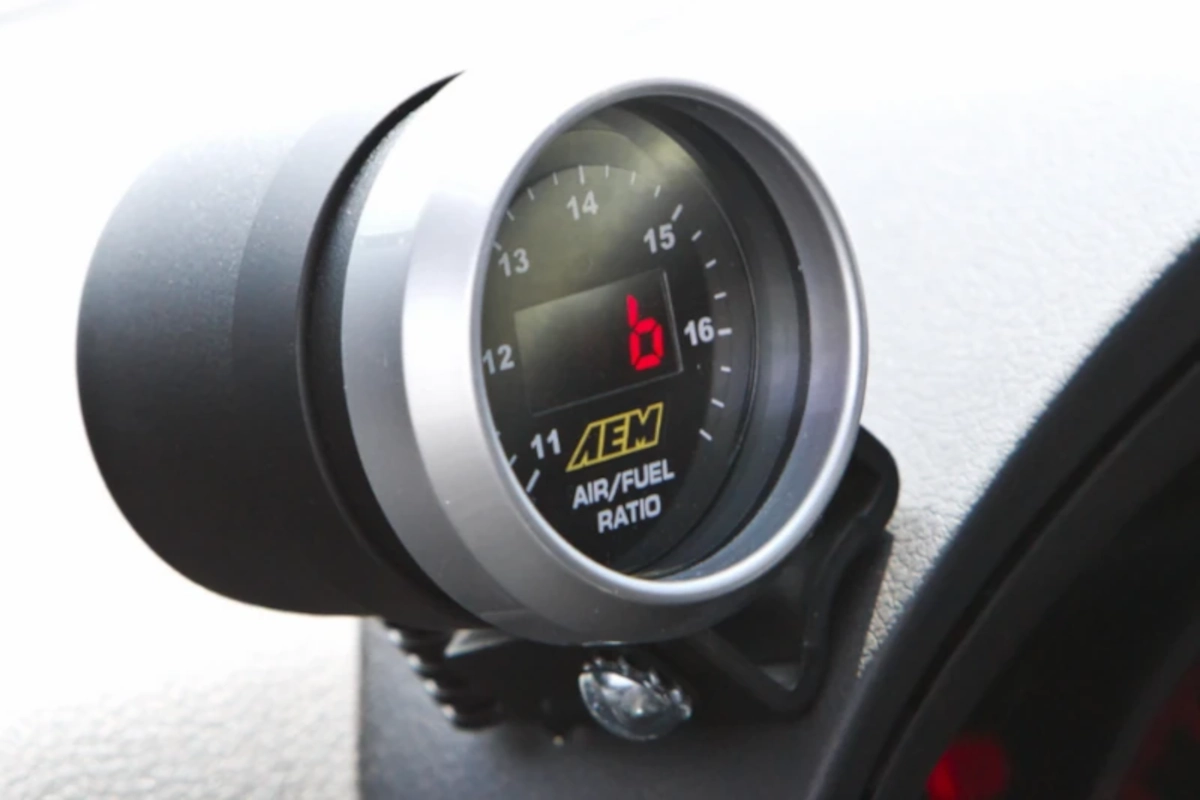We all know that fuel is the most important part of making sure your car’s engine is running because that is what allows it to have the power it needs to work and move your car. In that regard, what you should also know is that your engine doesn’t only need gas but also needs air to work.
This is where knowing how to read the air fuel ratio gauge comes in.
Here’s how to read an air fuel ratio gauge?
The way you read an air-fuel ratio (AFR) gauge is by looking at the ratio and then looking at the lambda value, which is your air fuel ratio divided by the stoich. If your AFR is higher than the stoich, your fuel mixture is lean. But if the AFR is lower than the stoich, that means that your fuel mixture is rich.

An AFR gauge is not one of the most common instruments that are usually seen in most cars but you should know that this is still one of the most useful instruments that you need to have if you want to monitor the fuel that goes into your engine.
That’s because the leanness or richness of the fuel may very well affect your engine’s overall performance.
How does an air fuel ratio gauge work?
When it comes to most engines that use combustion to work, what you probably already know is that the engine needs gasoline as the primary fuel that it needs to function. As such, gas is what allows the engine to move so that the entire car will also move. Without gas, your engine won’t be able to do its basic function of serving as the heart and soul of an entire vehicle.
But what you also need to know regarding combustible engines is that gas isn’t the only part of the equation that’s important. That’s because combustible engines also use other ingredients to work so that they can function. This is where air and a spark come in as the engine needs to mix the gas with air and use a spark for the combustion to happen. Essentially, combustion is what allows the engine to work.
Air is important here because gas doesn’t burn on its own and will not burn without the presence of air. As such, for combustion to happen, the gasoline needs to be mixed with air. Of course, the spark is responsible for combusting the two components.
That said, because of how important air is to your engine, there are actually instruments or gauges that will allow us to monitor the air that the engine uses with respect to the gas that it uses for combustion. As such, there needs to be a good ratio of air and fuel for the engine to work properly. This is where the air fuel ratio or AFR gauge comes in to help you monitor the ratio of air and fuel in your engine.
So, the way an air fuel ratio works is that it uses sensors that are linked to the voltage of the vehicle’s computer system so that they would have enough power to work. These sensors are capable of reading the levels of air and fuel in your engine as it works all while the sensors give back readings that are reflected on your AFR gauge.
Because the amount of air that the engine mixes together with fuel can change and vary as the engine is functioning while you are driving, your AFR gauge may reflect different readings from time to time because the data it receives from the sensor is in real time. And the results may also change depending on the sensitivity of the sensors.
With that said, not all cars have air fuel ratio gauges but you can install one in your car if you want to monitor the AFR. Of course, there are benefits when it comes to monitoring your AFR:
- If you have an AFR gauge, you will be able to reduce emissions especially if you know how to monitor your AFR and when you are making sure that your AFR is within the right range.
- An AFR gauge is also effective when it comes to fuel economy. The reason is that an air fuel ratio that is leaner than the stoich (to be explained later) will put your fuel mileage at an optimal level. That means that you will be able to travel greater distances while reducing the CO2 emissions and the fuel that your engine is using along the way.
- Monitoring the AFR through an AFR gauge can also help with engine performance. That’s because knowing the right air fuel ratios and carefully mapping them out through the different RPM ranges of your car will allow you to maximize the power output of your engine while also reducing the chances of causing a detonation within the engine. This can be quite useful for those who are into racing because it allows them to tell how to better make the most out of their engine performance.
How do you read an air fuel ratio gauge?
Now that you know what an AFR gauge is and how it works, let us now look into how you should be reading an air fuel ratio gauge so that you will understand what the values and the different signs mean.
So, first things first, what you need to know is what the AFR stands for. It is basically the amount of air with respect to the amount of fuel used. As such, if the AFR gauge reads at 14.7, that means that it is using 14.7 parts of air per one part fuel.
Next up, let’s talk more about what the stoich is. The stoich is basically the shortened term of stoichiometric ratio, which is often the ideal AFR value where the air and fuel mixture burns off completely without leaving any trace of air or fuel. In short, this is usually regarded as the “average” AFR value. The stoich that engines have will vary depending on what type of engine you have. However, for most gasoline engines, the stoich should be at 14.7.
The lambda value is also a useful value to know as it is another way for you to look at the AFR. However, it is not necessary as you can just simply rely on the AFR instead of looking at the lambda value.
Now that you know the basics, let’s look at how you should be reading an air fuel ratio gauge:
- First off, you need to look at where the pointer on the gauge is because that is the AFR.
- Monitor the AFR regularly so that you will know what the value means.
- So, if the value of the AFR on the gauge is higher than the stoich, that means that your fuel is lean and that your engine is using more air than fuel. Meanwhile, if the AFR is lower than the stoic, that means that your engine is using more fuel in comparison to the air it is using.
What is good reading for AFR?
Now that you know how to properly read the AFR and what the AFR reading means with respect to the stoich of your car, let’s look at the ideal readings of the AFR.
Light cruise: 13.5
If you are merely at idle or when you are cruising lightly, this is when you have just started your vehicle and that you have just shifted into gear. Shifting into gear and driving at a low mph value means that you are cruising lightly. So, if the AFR is lower than the stoich and is somewhere close to 13.5, this should be an ideal AFR for any vehicle.
Cruise: 14
When you have already gone past light cruising and you are already driving at steady mph values, that is when your vehicle is already at the state of cruising. This is one of the most common states in terms of driving especially when you are in driving in the city. So, in most cases, if you are cruising, it is ideal that your AFR should be at 14 because this will guarantee you better performance. But you can still do well with an AFR of 13 where the fuel combustion in your engine is richer.
Wide-open throttle: 12.5
When you are in wide-open throttle, that means that you are driving full out in a gear and where your car has reached peak horsepower. At this state, you might want to be at an AFR of 12.5 if you value performance. That’s because most people who are driving in this state are probably those who want their engines to perform at their best. But going richer than 12.5 will have the opposite effect on your engine.
Acceleration: 12
When you are accelerating up to cruising speed or if you want to overtake someone on the road, you want your engine to perform better. That is why you need your AFR to be richer than the stoich. As such, it might be a good value if your AFR is 12 if you are accelerating. But going too rich may end up making your engine feel a bit sluggish.
Fuel economy: 16.5
If you want to make the most out of your fuel while making sure that you are decreasing your CO2 emissions, having an AFR that’s higher than stoich should be a good value. In most cases, the best AFR in terms of fuel economy tends to be somewhere close to 16.5 but not higher because anything a lot higher than that may cause you to reach your engine’s lean burn limit.
Sources
It still runs: Connect Air Fuel Ratio Gauge
Find My answer: What should my AFR gauge read



